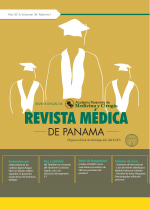Nefrotoxicidad en pacientes ingresados a la UCI con monitorización de niveles de vancomicina
Autores/as
DOI:
https://doi.org/10.37980/im.journal.rmdp.20211774Palabras clave:
nefrotoxicidad, niveles, vancomicinaResumen
En el 2009 un grupo de tareas encabezado por la Sociedad Americana de Enfermedades Infecciosas (IDSA) recomendó niveles de vancomicina entre 15-20 mg/L para asegurar efectividad ante el aumento de las concentraciones mínimas inhibitorias del Staphylococcus aureus resistente a Meticilina (MRSA). No existe evidencia concluyente sobre el impacto de estos nuevos niveles terapéuticos en el riesgo de nefrotoxicidad. Objetivo: determinar si existe una asociación entre los niveles plasmáticos valle de vancomicina y el desarrollo de nefrotoxicidad, independientemente de la presencia o no de otros factores de riesgo para lesión renal. Metodología: se realizó un estudio de cohorte retrospectivo. Se estudiaron pacientes ingresados a UCI del Hospital Santo Tomás, entre el 01 de enero del 2018 y el 31 de diciembre del 2018, que fueron tratados con vancomicina. Se realizó análisis bivariado y multivariante. Resultados: 54 pacientes entraron al análisis; se inició la monitorización de niveles plasmáticos principalmente después de la cuarta dosis (77.78%); 13 pacientes (24.07%) desarrollaron nefrotoxicidad por vancomicina; en el análisis bivariado la única variable con una relación estadísticamente significativa con nefrotoxicidad fue tener niveles valle >15 mg/L (P=0.003). El análisis de regresión logística multivariante mostró que los niveles valle >15 mg/L tienen una asociación estadísticamente significativa con nefrotoxicidad (OR, 15.20 [95% IC, 1.48-156.11]; P=0.022), la cual es independiente de otros confusores. Conclusiones: Los niveles valle de vancomicina >15 mg/L se asociaron de forma independiente a nefrotoxicidad por vancomicina. Se deben realizar estudios prospectivos para definir la asociación de niveles valle de vancomicina con el desarrollo de nefrotoxicidad.
Publicado
Número
Sección
Licencia
Derechos de autor 2021 Infomedic InternationalDerechos autoriales y de reproducibilidad. La Revista Médica de Panama es un ente académico, sin fines de lucro, que forma parte de la Academia Panameña de Medicina y Cirugía. Sus publicaciones son de tipo acceso gratuito de su contenido para uso individual y académico, sin restricción. Los derechos autoriales de cada artículo son retenidos por sus autores. Al Publicar en la Revista, el autor otorga Licencia permanente, exclusiva, e irrevocable a la Sociedad para la edición del manuscrito, y otorga a la empresa editorial, Infomedic International Licencia de uso de distribución, indexación y comercial exclusiva, permanente e irrevocable de su contenido y para la generación de productos y servicios derivados del mismo. En caso que el autor obtenga la licencia CC BY, el artículo y sus derivados son de libre acceso y distribución.






